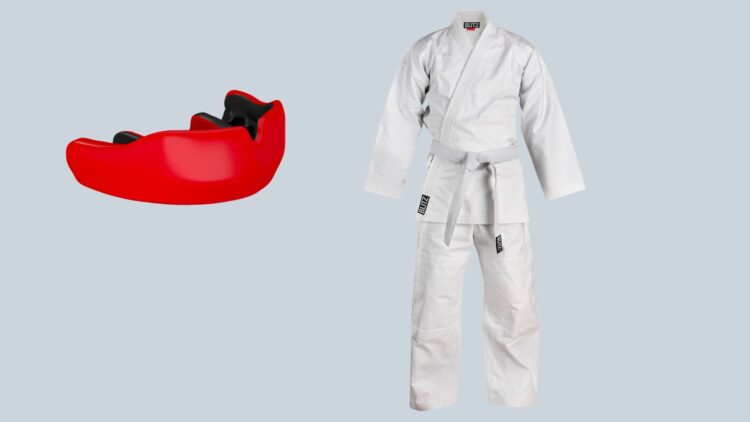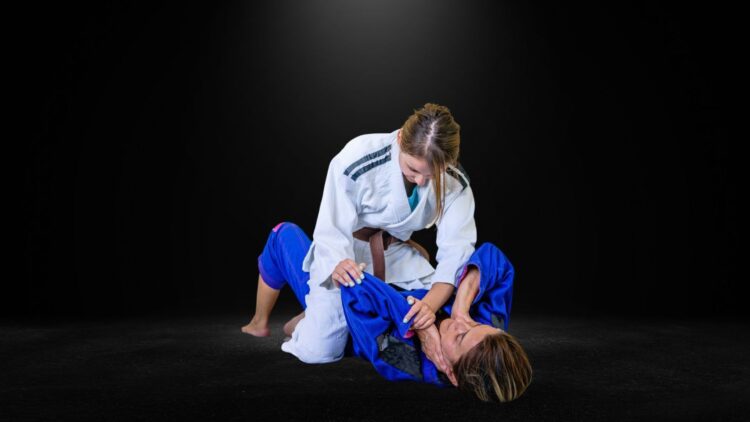
OBJECTIVE OF JUJUTSU: Receive the highest score from the judges or successfully submit the opponent.
NUMBER OF PLAYERS: 2 players
MATERIALS: Gi, mouthguard
TYPE OF GAME: Sport
AUDIENCE: 5+
OVERVIEW OF JUJUTSU
Jujutsu (alternatively spelled jiu-jitsu) is a Japanese martial art practiced worldwide. It is a style of (mostly) unarmed combat that can be used offensively and defensively to subdue both armed and unarmed opponents.
Developed in 1530 in Japan, the first jujutsu school taught students how to fight with strikes, holds, throws, and paralyzing attacks. This training style became the foundation of Japanese warrior training throughout the 17th century, with the noble Samurai even using it to complement their swordsmanship and close-quarters combat skills.
Although the sport started out mainly incentivizing strikes and blows, the martial art’s focus shifted toward holds, throws, and grappling skills, all of which provided the foundations for other combat sports, such as judo and Brazilian jujutsu. Many jujutsu schools also utilize weapons, although they are primarily for decorative purposes.
As a sport, jujutsu is largely overshadowed by the immensely popular Brazilian jujutsu in the West. This has led to traditional jujutsu becoming more of a performance rather than a competition. There is even an event known as “duos” featuring two teammates displaying jujutsu techniques on each other in an attempt to make it appear as realistic as possible.
SETUP
EQUIPMENT

- Gi: A gi is a standard robe-like uniform worn in many Japanese martial arts, such as judo and karate. Each sport has a slightly different style of gi, although all are very similar.
- Mouthguard: While not required, mouthguards are recommended to protect the teeth from any strikes to the head or violent throws.
BELTS
Like many other martial arts, jujutsu has a belt color ranking system. These belts are earned by jujitsukas (those who practice the sport) based on their training progression. So, each time they move up a level, they also go up a belt color. In other words, the color of the belt indicates the jujitsuka’s ability level.
Here is the belt ranking system in jujutsu:
- Red (before grading)
- White (7th kyu)
- Yellow (6th kyu)
- Orange (5th kyu)
- Green (4th kyu)
- Blue (3rd kyu)
- Purple (2nd kyu)
- Brown (1st kyu)
- Black (1st dan)
GAMEPLAY

There are three main disciplines of the sport. These include:
1) DUO
Duo jujutsu is essentially a self-defense demonstration performed by two teammates. One plays the role of the tori (attacker) and the other the uke (defender). In some duo events, a referee will randomly call out an attack for the tori to perform, sometimes without disclosing this information to the uke. Even though this is a “friendly” fight between teammates, spectacular throws, powerful punches, and other impressive maneuvers are still performed.
During these demonstrations, judges score each team based on speed, accuracy, control, and realism for a total score between 0 and 10.
2) FREEFIGHTING
Freefighting is a competitive style of jujutsu that allows two competitors to utilize a number of grappling, striking, and submission techniques against each other.
3) JAPANESE/NE WAZA
Usually just referred to as “Japanese jujutsu”, this discipline of the sport has both athletes competing to score a submission on each other using grappling techniques. With no striking allowed, this style of jujutsu closely resembles a form of wrestling.
JUJUTSU PRINCIPLES
Like all martial arts, jujutsu is more than just a combat sport. The name “jujutsu” essentially translates to “the art of giving way” or “the art of being gentile”. The purpose of this name likely has to do with the fact that jujutsu has always been centered around throws, pins, and joint-lock techniques as opposed to strikes. Although these techniques are far from gentle (in fact, many are intended to be crippling or fatal), this name likely has more to do with the fact that jujutsu is used to subdue a threat.
BRAZILIAN JUJUTSU
Brazilian jujutsu (BJJ) is an extremely fast-growing sport in the United States that actually stems from judo, not traditional jujutsu. Much of the reason for this sport’s immense popularity is that BJJ is considered one of the most efficient forms of combat, making it extremely useful for self-defense.
This idea of efficiency is precisely why the sport was developed in the first place, as the Brazilian Gracie family found that the judo skills they were learning (grappling, throws, etc.) were much less practical and harder to learn than ground fighting skills. This resulted in BJJ becoming a martial art centered around bringing an opponent to the ground and forcing them into submission through technical joint locks and chokeholds.
END OF GAME
In duo jujutsu, the winner is the team that receives the highest score from the judges.
In freefighting and Japanese jujutsu, the winner is the opponent who physically dominates their opponent and scores a submission.
- 30 GAMES TO PLAY OVER TEXT - April 22, 2024
- 20+ FREE PRINTABLE BABY SHOWER GAMES - April 16, 2024
- 20+ College Party Games for the Best Night Ever! - April 2, 2024